The Green Faerie
/8 Comments/in Gardening, Uncategorized/by Lee ReichIn a Smoke-Filled Café . . .
What you are about to read might have been improved upon if I had been writing with la fée verde (the green fairy) looking over my shoulder. Or better yet, if I also was writing from a smoke-filled cafe in Paris.

The Green Faerie, Viktor Oliva
Or even better, from a smoke filled cafe at the turn of the 19th century, hanging out with the likes of Ernest Hemingway, Oscar Wilde, James Joyce, and Lord Byron.
There’s a certain mystique with drinking absinthe, la fée verde, a distilled spirit concocted from various herbs which might include tansy, fennel, green anise, and bee balm. The most important ingredient is, of course, Artemisia absinthe, absinthe, the plant. Absinthe is one of many plants in the genus Artemisia, commonly referred to as mugwarts or wormwoods.
Full disclosure: I generally am not fond of this genus because it’s one of my worst weeds. My artemisiac nemesis is not absinthe, though, but common wormwood (Artimesia vulgaris). This ugly, perennial weed perennially keeps poking up through the leafy mulch beneath a clump of delphiniums in one corner fo the garden.
Whence the Green Faerie?
But back to absinthe, the drink. It’s been accused of being an addictive, psychoactive drug and hallucinogen, which led to its being banned in the early 1900s almost everywhere except the United Kingdom.
Artemisias all contain potent chemicals, and the chemical of potency of absinthe is thujone. Not that absinthe has cornered the market on thujone; it’s also found in some junipers, tansy, some mints, and arborvitae, whose generic name is Thuja.
As it turns out, the concentration of thujone in absinthe is too low to invite visits from the green fairy.

The Absinthe Drinker, Picasso
That invite comes from alcohol, 45-74%, that’s responsible — duh — for absinthe’s bringing on hallucinations and other psychological changes. And its addictiveness.
Still, thujone can be toxic, which is perhaps why absinthe sold in the U.S. must contain less than 10 ppm thujone. Which has led to some rumors that American absinthe isn’t “real” absinthe. Not true because, first of all, absinthe is not a well defined alcoholic drink. And secondly, less thujone does not mean less absinthe, the plant, in the bottle. Particular absinthe plants vary in their thujone concentration. And thirdly, thujone concentration in the absinthe poured out of the bottle will vary also with length and method of storage; it decomposes over time.
Most artemisias are very bitter, so enjoying absinthe, the drink, is an acquired taste. (I’ve never tasted absinthe, nor, with my aversion to bitter flavors, do I intend to.) And even then, absinthe is not a liquid anyone would drink straight up.

The Absinthe Drinker, Degas
All of the various methods of imbibing it involve sweetening it with sugar and diluting it with some iced water. Well, perhaps not all methods in this era of craft cocktails.
Absinthe, the plant, is not hard to grow. It’s a perennial that’s native to Europe but has naturalized in the U.S. and Canada. (Uh oh.) It enjoys a dry, fertile soil, especially one rich in nitrogen. Artemisias generally have relatively inconspicuous flowers but sometimes attractive, hoary leaves; absinthe’s leaves are gray-green on their upper sides and white on their undersides. Dusty Miller is the showiest of the artemisias, with powdery, white leaves.
My experience with common wormwood makes the ease of propagating absinthe somewhat frightening. Cuttings root readily and the plant self-seeds generously.
One Artemesia I Do Like
Now that I think of it, there is one artemesia that I do especially like, despite its potential weedy nature. Sweet Annie (A. annua) is a self-seeding annual whose tiny seeds sprout every spring to grow into 2 to 5 foot tall sweetly fragrant plants. 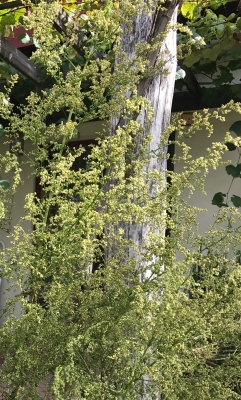 The sweet, resiny aroma is retained in air-dried plants for years. I keep a clump hanging upside down near my front door so that the aroma can waft into the air when the door is opened or someone brushes past.
The sweet, resiny aroma is retained in air-dried plants for years. I keep a clump hanging upside down near my front door so that the aroma can waft into the air when the door is opened or someone brushes past.
When l’heure verte (the green hour, as 5 pm was called among absinthe enthusiasts (or addicts) in late 19th century France arrives, you won’t see me sitting at a table peering down into my glass of absinthe. The only artemesia that I might imbibe would be Sweet Annie, not because it tastes good. If I ever contract malaria, Sweet Annie is the ticket. It’s a traditional Chinese treatment and has in recent decades been incorporated into modern treatments also. So that’s another reason to like Sweet Annie, but not absinthe.
Fruit in Winter!
/13 Comments/in Flowers, Fruit/by Lee Reich
Snow Mulching
Only four inches of snow fell a a couple of weeks ago but I decided anyway to go outside and mulch. And shovel snow. And shovel snow and mulch.
What I was trying to do, besides clear snow from the driveway, the paths, and the doorway to the greenhouse, was to create a microclimate. A microclimate is a small area where the climate is slightly different from the general climate.
One group of plants in need of this special treatment are my maypops, Passiflora incarnata. Yes, Passiflora genus is that of passionflower, and maypop is a hardy species of passionflower, native to eastern U.S.. It bears the same breathtaking flowers, whose intricate arrangement of flower parts was used by Christian missionaries to teach native Americans about the “passion” of Christ, as the tropical species. 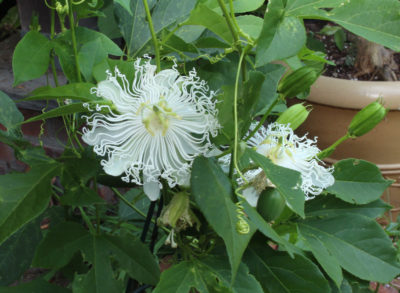 And, like the tropical species, flowers are followed by egg-shaped fruits filled with air and seeds around which clings a delectable gelatinous coating. You know the flavor if you’ve ever tasted Hawaiian punch.
And, like the tropical species, flowers are followed by egg-shaped fruits filled with air and seeds around which clings a delectable gelatinous coating. You know the flavor if you’ve ever tasted Hawaiian punch.
Maypop parts ways with tropical passionflowers, which are woody vines, in being an herbaceous vine. The roots live year ‘round but the above ground portions of the plant die back each winter.
Besides creating a microclimate for the maypops, I also chose to plant them in an existing microclimate to their liking. That is on the south side of my woodshed, where the sun bears down to provide extra warmth in summer. (Another goal was to let the vines each summer cover a trellis that would give the woodshed some shade to prevent the firewood from drying out to much.) These plants of southeastern U.S. like their summers hot.
Soil moderates temperatures so never get as cold in winter as the air — or, in summer, as hot as the air. Five feet down, soils remain at a balmy 50°F year ‘round. Shallower depths are commensurately colder in winter and warmer in summer than deeper down.
Maypop is borderline hardy this far north. Insulating the ground around the plants will keep temperatures around the roots from dropping too low. Hence the snowy mulch.
As maypop grows through the summer, new flowers and then fruits appear. The longer the growing season, the more fruits the plants bear. Although I want to keep the ground from getting too cold in the depths of winter, I’d like it to warm up quickly in spring to get the plants going.
Wood chips, straw, snow, or any other mulch is going to put the brakes on soil warming, so, ideally, the mulch should be removed after the coldest part of winter is past. Except if that mulch is snow, which will melt.
Ugly but Delicious
Wandering through the snow to the other side of the farmden, I come upon another fruit, this one ready to pick and eat right now! Medlar. (Medlar and maypop each warranted a whole chapter in my book Uncommon Fruits for Every Garden.)
Medlar fruits resemble small, russeted apples (a relative), tinged dull yellow or red, with their calyx ends (across from the stems) flared open.  It’s peak of popularity was in the Middle Ages. And though popular, it was made fun of for it’s appearance; Chaucer called it the “open-arse” fruit.
It’s peak of popularity was in the Middle Ages. And though popular, it was made fun of for it’s appearance; Chaucer called it the “open-arse” fruit.
That old-fashioned look extends to the tree itself, which even this time of year is attractive with the elbowed contortions of its branches. In spring, the blossoms, which resemble wild roses, are borne singly at the ends of branches and, opening late so that each is cradled in already opened whorl of leaves.
But back to the fruit; its got another quirk, besides its appearance. It’s inedible when first harvested. But after the fruit has sat for a couple of weeks or more indoors, a process called bletting, the once-hard, white flesh turns to brown mush.
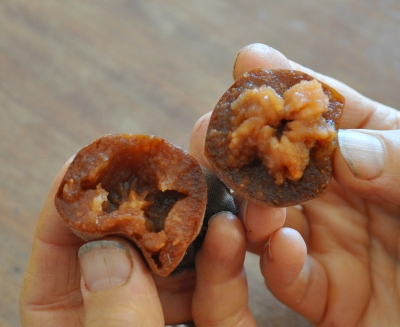
Medlar, after bletting
Yechhhh! The flavor, though, has a refreshing briskness with winy overtones, like old-fashioned applesauce laced with cinnamon.
Fruits left on the tree also blet, and my trees are loaded with fruits.
Uh oh. Although medlar is generally pest-free, I see that many of the fruits have what looks like some sort of pest damage. Instead of the smooth, brown mush, flesh of damaged fruits is drier, almost powdery. What is it?
(Almost?) Hardy Orange
More snow more recently fell, and with it came bitter cold, which made me fear for the survival of my hardy orange, Citrus trifoliata. This orange is allegedly hardy to zone 5, but still . . .
The plant is only about four feet tall and there was plenty of snow so I just started piling snow on top of it. The ends of some branches remained exposed, which is okay because they can tell me whether the plant is really hardy.
Hardy orange bears flowers and fruits very similar to sweet oranges except that hardy orange fruits are bitter and very seedy. They could be used — in moderation — for flavoring, though. 
 Mostly I grow it for the novelty of an outdoor orange tree, for the sweetly fragrant blossoms, and for the decorative, green, swirling, recurved spiny stems.
Mostly I grow it for the novelty of an outdoor orange tree, for the sweetly fragrant blossoms, and for the decorative, green, swirling, recurved spiny stems.
Come spring, I;’ll know if just how hardy the hardy orange really is. Temperature the night after covering it dropped to minus 18° Fahrenheit.
Life Goes On
/14 Comments/in Design, Fruit/by Lee Reich
The dark green wreath was tied with red ribbons and gliding towards me, in its progress stirring up snowflakes gently floating out of the grey sky. No, the wreath was not hanging from a horse-drawn sled, but was plowing through the frigid air affixed to the chrome grille of a gleaming white Cadillac! Here we are in the twenty-first century, still infusing a breath of life into our winters with cut evergreen boughs, just as did the ancient Egyptians, Persians, Jews, Christians, and Druids.
Whether for Christmas, for the ancient winter festival of Saturnalia, or for any other tradition, a wreath celebrates the continuity of life through winter. Evergreens are favorite wreath materials because their year long green flaunts winters’ apparently lifeless cold.
A few evergreen boughs tied together make a doorway more inviting or a room more cozy in winter, but a bona fide wreath creates something special. And the actual making of a wreath can be an end in itself this time of year.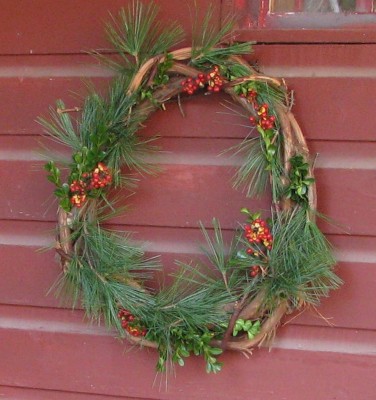
Plenty of native and cultivated plants, many probably growing right in your backyard, could supply evergreen leaves for wreaths. Depending on the weather and the variety, needles of some junipers might still look bright green, although many turn purplish in the cold. Norway spruce always looks rich green, as do, with a softer look, the long, slender needles of white pine. With flattened sprays of scale-like leaves, arborvitae is another good choice, surely one of the best choices for a winter wreath when you translate its name to “tree of life.”
Don’t forget broadleaf evergreens also. Mahonia, holly, leucothoe, rhododendron, boxwood, and English ivy are suitable broad-leaf evergreens for a wreath. Indoors, none of the broadleaf evergreens will hold their leaves in a wreath as long as the needle-leaved evergreens.
To get a little wilder — more in keeping with the raucous Saturnalia celebrated in ancient Rome — use some evergreens with splotches or borders of yellow on them. No evergreen has all yellow leaves, but Gold Star and Kuriwao Sunburst junipers, for example, have yellow-tipped leaves. Midas Touch and Variegata are broadleaved evergreens, varieties of Japanese holly, with spots or splotches of yellow on their otherwise green leaves.
Okay, let’s calm down and get to some practical matters. Any wreath needs a support on which to mount the branches. That support could be a purchased styrofoam “doughnut” or one you make yourself from coat hangars. For an “organic” frame, readily available from the wild or backyard pruning, grape vines come to mind. Vines of bittersweet or virginia creeper would also work. Before grabbing at any wild vine, make sure you can identify and avoid poison ivy — it can cause rashes even this time of year.
Wrap any of these vines into a doughnut shape, weaving it into itself and weaving in new lengths as you go around and around. 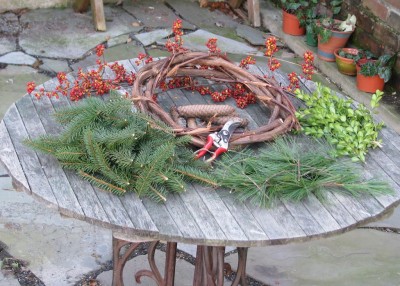 A few loops of string or thin wire can unobtrusively firm everything in place.
A few loops of string or thin wire can unobtrusively firm everything in place.
Next, wire, glue or tuck small bunches of evergreens onto the base, with all the bunches facing the same direction. Be generous so as to create a harmonious backdrop for the colorful stuff that comes next.
A walk in the woods or around your yard should turn up some colorful fruits, even this time of year. Still abundant are wild rose hips, bittersweet, winterberry, and barberry. Other seed pods are also good as ornaments. 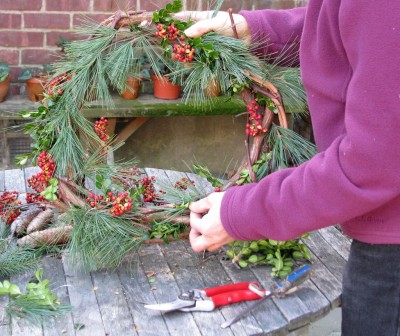 Besides the obvious — pine cones — also consider the flattened silvery pods of silver dollar plant, the wiry ones of love-in-a-mist, and the shaggy manes of clematis. If yet more ornamentation is wanted, there’s always chains of cranberries or popcorn strung together.
Besides the obvious — pine cones — also consider the flattened silvery pods of silver dollar plant, the wiry ones of love-in-a-mist, and the shaggy manes of clematis. If yet more ornamentation is wanted, there’s always chains of cranberries or popcorn strung together.
When hints of spring are in the air and you tire of your wreath, just compost it or throw it in the woods (if made from all organic materials). For now, though, deck the halls.
Note: The “comments” part of these blog posts has been erratically functional. It’s fixed! So fire away. Or just send a comment to test that it’s now working. Thanks.

